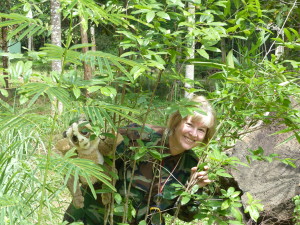Since leaving Cipaganti, the puppets and I have settled in at the beautiful Dao Tien Endangered Primate Species Centre in southern Viet Nam. Run by the Endangered Asian Species Trust (EAST), Dao Tien focusses on the rescue, rehabilitation, and where possible, the release of endangered primates native to south Viet Nam.

I wake every morning at 5.15 to the wonderful whoops of golden cheeked gibbons duetting. Much better than an alarm clock! The gibbons at Dao Tien are all victims of illegal hunting and trade. Most were taken from their families at an early age and kept in appalling conditions, so it takes years to nurture them back to physical and psychological health and give them a chance to return to the forest. Some are too damaged by human contact to survive in the wild and will live out their lives at Dao Tien. Take a look at EAST’s website www.go-east.org to see some of the gorgeous primates in our care at the moment.
So how do the puppets and I fit in? By day we’re working with students in Thanh Binh High School as part of my Whoop Troop project, connecting with students in LFP’s Alum Nature Club and Situwangi School to learn about native animal species common to Viet Nam and Java. The Thanh Binh Troop are creating a fantastic puppet show which they will perform in six villages around Cat Tien National Park. Education and awareness raising are an important part of EAST’s work to help stop the illegal trade in endangered primates. We run two daily tours of the Centre and have many Vietnamese and foreign visitors coming to see what we do and learn about primate conservation.
By night, it’s the turn of the pygmy slow lorises to emerge. The huge increase in the illegal trade in lorises for pets, tourist props and medicine mean that we’re completely full of rescued pygmy lorises, with a new enclosure planned this year to keep up with the flood of new arrivals. If you think Javan lorises are amazing, click here to take a look at the pygmy slow loris on the Endangered Asian Species Trust’s Facebook page! At only 400g, the tiny pygmy loris is the smallest loris species, but they still pack the venomous bite of their larger cousins.
Last week LFP’s Dan Geerah visited Dao Tien bringing the equipment to detect ultrasonic animal calls. After some expert training from Dan, I’ve gone nocturnal to find out if the pygmy slow lorises of Viet Nam use ultrasonic calls to communicate. We’ve recently released some pygmy lorises so it’s a great opportunity for me to find out if they use these secret calls. Understanding more about pygmy loris communication can help with rehabilitation and release programmes and in monitoring wild loris populations. My favourite night shift is midnight to 5 a.m., which starts with tranquil hours in the forest and ends with the slow gathering of dawn and the sounds of waking birds and insects. When I hear the whoops of Dao Tien’s gibbons and their wild neighbours in Cat Tien National Park, I know it’s time to head home for bed.
